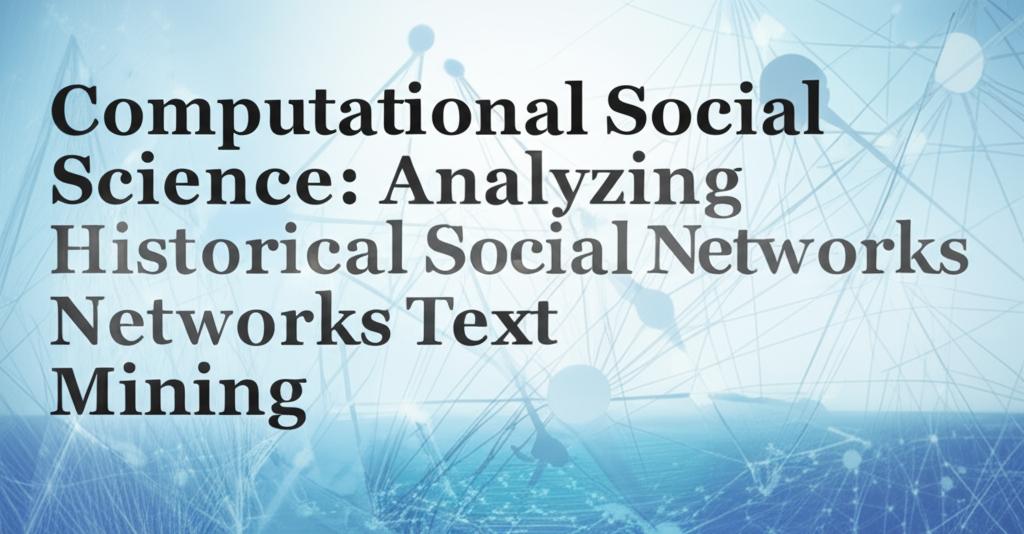Computational social science is revolutionizing our understanding of the past by enabling the analysis of historical social networks through text mining. This interdisciplinary field combines computational methods with vast digital archives of historical texts, such as letters, diaries, administrative records, and books, to unearth theories of human behavior and map the intricate connections between individuals and groups.
Harnessing Text as DataThe core of this approach lies in treating text as a rich source of data. Advances in natural language processing (NLP) and machine learning allow researchers to move beyond manual, close readings of historical documents. Instead, these powerful tools can process and analyze massive volumes of text with remarkable speed and increasing accuracy. This process typically involves:
- Digitization and Data Collection: The initial step involves gathering and digitizing historical texts. This creates large-scale digital corpora accessible for computational analysis. Examples include Google Books, digitized government archives, and collections of personal correspondence.
- Text Pre-processing: Raw texts are cleaned and standardized. This involves tasks like tokenization (breaking text into individual words or phrases), removing irrelevant "stop words" (e.g., "the," "and"), and stemming or lemmatization (reducing words to their root form).
- Feature Extraction and Representation: The processed text is then transformed into a quantitative format that computers can understand. This can involve techniques like "bag-of-words" models, which represent texts based on word frequencies, or more sophisticated methods that capture semantic relationships between words.
- Analysis and Interpretation: Various text mining techniques are then applied to this structured data to extract meaningful information about social networks.
Several text mining techniques are particularly valuable for reconstructing and analyzing historical social networks:
- Named Entity Recognition (NER): This technique identifies and categorizes key entities in text, such as names of people, organizations, locations, and dates. By extracting these entities from historical documents, researchers can identify the actors within a potential network and their temporal and spatial contexts.
- Relationship Extraction: Going beyond identifying entities, this technique aims to uncover the relationships between them. For example, analyzing correspondence might reveal patterns of communication, collaboration, or influence between historical figures.
- Topic Modeling: This unsupervised machine learning technique discovers latent themes or topics within a collection of documents. By analyzing the topics discussed by different individuals or groups, researchers can infer shared interests, intellectual connections, or ideological alignments, which can serve as proxies for social ties. This helps reveal "hidden communities of interest" – groups sharing similar semantic content even if their direct social relationships are not explicitly documented.
- Sentiment Analysis: This method determines the emotional tone (positive, negative, neutral) expressed in a piece of text. Applied to historical documents like letters or diaries, sentiment analysis can shed light on the nature and quality of relationships within a social network, indicating friendship, animosity, or support.
- Network Analysis from Text: By combining the information extracted through NER, relationship extraction, and topic modeling, researchers can construct network graphs. In these graphs, individuals or groups become "nodes," and the identified relationships or shared characteristics become "edges" connecting them. Standard social network analysis metrics (e.g., centrality, clustering, homophily) can then be applied to these text-derived networks to understand their structure and dynamics.
The application of text mining to historical social networks is yielding new insights across various domains:
- Mapping Intellectual Networks: Projects like "Mapping the Republic of Letters" at Stanford University use text mining to analyze correspondence networks among early modern scholars, revealing how ideas and knowledge flowed across geographical and social boundaries. Similarly, "Six Degrees of Francis Bacon" maps connections between individuals in early modern Britain.
- Understanding Political Dynamics: Analyzing political discourse from historical texts can reveal evolving political alignments, polarization, and the spread of ideologies.
- Tracing Cultural Trends (Culturomics): By analyzing vast digital libraries like Google Books, researchers can track linguistic shifts, the evolution of concepts, and changing cultural preoccupations over time, which can indirectly inform our understanding of the social contexts in which these changes occurred.
- Revealing Hidden Communities: As mentioned, topic modeling allows for the identification of groups based on shared textual content, uncovering connections that might not be apparent through traditional historical methods.
- Diachronic Analysis: Researchers can model networks over different time periods to map the evolution and genealogical relationships between communities and their ideas.
Despite significant advancements, analyzing historical social networks with text mining presents several challenges:
- Data Quality and Bias: Historical archives can be incomplete, fragmented, or biased towards certain voices or perspectives. The digitization process itself can also introduce errors.
- Language Evolution and Ambiguity: Historical language, including spelling variations, evolving word meanings, and nuanced expressions, can be difficult for current NLP models to interpret accurately.
- Contextual Understanding: Fully grasping the meaning and significance of historical texts often requires deep contextual knowledge that computational tools may lack.
- Computational Complexity and Resources: Processing and analyzing very large datasets require significant computational power and specialized expertise.
- Interpretation and Validation: While computational methods can identify patterns, their historical significance still requires careful interpretation and validation by domain experts.
The future of this field lies in developing more sophisticated NLP models that can better handle the complexities of historical language and context. Integrating diverse data sources, including images and material culture, alongside textual data, will provide richer and more nuanced reconstructions of historical social networks. Furthermore, fostering closer collaboration between historians, social scientists, and computer scientists is crucial for ensuring that computational methods are applied thoughtfully and contribute meaningfully to our understanding of the past. As text mining techniques continue to mature and digital archives expand, the potential to unlock hidden social structures and dynamics from historical texts will only grow, offering unprecedented insights into the fabric of past societies.

